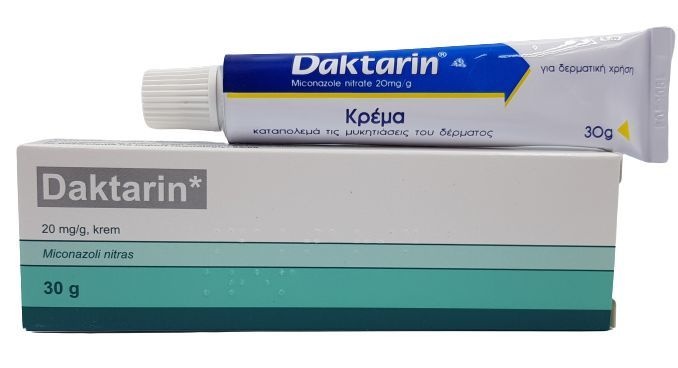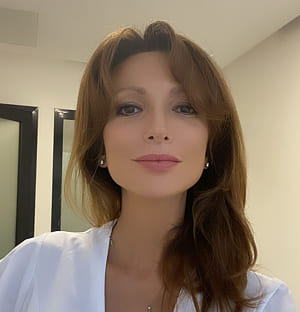

Daktarin

Ask a doctor about a prescription for Daktarin

How to use Daktarin
Package Leaflet: Information for the User
Warning! Keep the leaflet, the information on the immediate packaging is in a foreign language!
Daktarin(Daktarin 2%-Cream)
20 mg/g (2%), cream
Miconazole nitrate
Daktarin and Daktarin 2%-Cream are different trade names for the same medicine.
Read the leaflet carefully before using the medicine, as it contains
important information for the patient.
This medicine should always be used exactly as described in this patient leaflet or as directed by a doctor or pharmacist.
- The leaflet should be kept in case it needs to be read again.
- If advice or additional information is needed, a doctor or pharmacist should be consulted.
- If the patient experiences any side effects, including any not listed in this leaflet, they should inform their doctor, pharmacist, or nurse. See section 4.
- If there is no improvement or the patient feels worse, they should contact their doctor.
Table of Contents of the Leaflet
- 1. What is Daktarin cream and what is it used for
- 2. Important information before using Daktarin cream
- 3. How to use Daktarin cream
- 4. Possible side effects
- 5. How to store Daktarin cream
- 6. Contents of the pack and other information
1. What is Daktarin cream and what is it used for
Daktarin cream contains the active substance miconazole. Miconazole has antifungal effects, including on dermatophytes and yeasts, as well as antibacterial effects on Gram-positive rods and cocci.
Miconazole is also used to treat fungal infections that are secondarily infected.
Miconazole usually eliminates skin itching, which often accompanies infections caused by dermatophytes and yeasts. The itching disappears before other signs of healing appear.
Indications for Use
Daktarin cream is indicated for the treatment of fungal skin infections caused by dermatophytes, yeasts, and other fungi, such as: scalp ringworm, body ringworm, hand ringworm, and athlete's foot (tinea pedis).
Due to its antibacterial effect, Daktarin cream may be used in fungal infections secondarily infected by bacteria (e.g., diaper rash).
2. Important Information Before Using Daktarin Cream
When Not to Use Daktarin Cream:
- if the patient is allergic to miconazole, other similar antifungal medicines, or any of the other ingredients of this medicine (listed in section 6),
- for the treatment of fungal infections of the hairy scalp, mucous membranes, nails, or damaged skin.
Warnings and Precautions
Before starting to use Daktarin cream, the patient should discuss it with their doctor or pharmacist.
If symptoms of an allergic reaction or skin irritation occur, treatment should be discontinued and a doctor consulted.
Contact between Daktarin cream and the eyes should be avoided.
Daktarin Cream and Other Medicines
The patient should tell their doctor about all medicines they are currently taking or have recently taken, as well as any medicines they plan to take.
In patients taking oral anticoagulants, such as warfarin, monitoring of anticoagulant activity is necessary. The effects and side effects of certain other medicines (e.g., oral blood sugar-lowering medicines and phenytoin) may be enhanced when used concomitantly with Daktarin cream.
Caution should be exercised when using other medicines concomitantly.
Pregnancy and Breastfeeding
If the patient is pregnant or breastfeeding, thinks they may be pregnant, or plans to have a child, they should consult their doctor or pharmacist before using this medicine.
The doctor will weigh the potential risks and benefits of using the medicine. It is not known whether the active substance of the medicine, miconazole, passes into breast milk. Therefore, Daktarin cream should only be used in breastfeeding women on the advice of a doctor.
Driving and Using Machines
No effects on the ability to drive or use machines have been observed.
Daktarin Cream Contains 2 mg of Benzonic Acid per g of Cream
Benzonic acid may cause local irritation. Benzonic acid may increase the risk of jaundice (yellowing of the skin and whites of the eyes) in newborns (up to 4 weeks of age).
Daktarin Cream Contains Butylhydroxyanisole
The medicine may cause local skin reactions (e.g., contact dermatitis) or eye and mucous membrane irritation.
3. How to Use Daktarin Cream
This medicine should always be used exactly as described in this patient leaflet or as directed by a doctor or pharmacist. If in doubt, the patient should consult their doctor or pharmacist.
Dosage
Daktarin cream is applied to the affected areas of the skin, usually twice a day.
If Daktarin cream is used concomitantly with Daktarin medicated powder, it is recommended to use both formulations once a day.
The duration of treatment is from 2 to 6 weeks, depending on the location and severity of the lesions.
After all symptoms and lesions have disappeared, treatment should be continued for at least 1 week.
If the patient feels that the effect of the medicine is too strong or too weak, they should consult their doctor.
Using More Than the Recommended Dose of Daktarin Cream
Using the medicine too frequently may cause skin irritation, which usually disappears after stopping the use of the medicine.
The patient should immediately consult their doctor in case of accidental ingestion of the medicine.
Daktarin cream is for external use only and should not be taken orally.
Missing a Dose of Daktarin Cream
The patient should not use a double dose to make up for a missed dose.
Stopping Treatment with Daktarin Cream
If the patient has any further doubts about using this medicine, they should consult their doctor or pharmacist.
4. Possible Side Effects
Like all medicines, Daktarin cream can cause side effects, although not everybody gets them.
The frequency of possible side effects listed below is defined as follows:
very rare (occurs in less than 1 in 10,000 patients).
Very rarely, the following have been reported after the medicine was placed on the market: hypersensitivity reactions, including severe reactions such as anaphylaxis and angioedema, hives, contact dermatitis, rash, redness, itching, skin inflammation, pale spots on the skin, burning sensation on the skin, disorders at the application site, including irritation, burning, itching, and warmth at the application site of Daktarin cream.
Reporting Side Effects
If the patient experiences any side effects, including any not listed in the leaflet, they should inform their doctor, pharmacist, or nurse. Side effects can be reported directly to the Department of Monitoring of Adverse Reactions to Medicinal Products of the Office for Registration of Medicinal Products, Medical Devices, and Biocidal Products
Al. Jerozolimskie 181C, 02-222 Warsaw
Phone: +48 22 49 21 301
Fax: +48 22 49 21 309
Website: https://smz.ezdrowie.gov.pl
Reporting side effects will help to gather more information on the safety of the medicine.
5. How to Store Daktarin Cream
Do not store above 25°C.
The medicine should be kept out of sight and reach of children.
Daktarin cream should not be used after the expiry date stated on the packaging. The expiry date refers to the last day of the month stated.
The shelf-life after first opening: 3 months.
Medicines should not be disposed of via wastewater or household waste. The patient should ask their pharmacist how to dispose of medicines they no longer need. This will help protect the environment.
6. Contents of the Pack and Other Information
What Daktarin Cream Contains
- The active substance is miconazole nitrate. 1 g of cream contains 20 mg of miconazole nitrate.
- The other ingredients are butylhydroxyanisole (E 320), benzonic acid (E 210), liquid paraffin, macrogol glycerol oleate, macrogol 6 and macrogol 32 glycerol stearate, purified water.
What Daktarin Cream Looks Like and Contents of the Pack
The pack consists of an aluminum tube with an internal coating and a polypropylene screw cap, in a cardboard box.
For more detailed information, the patient should contact the marketing authorization holder or the parallel importer.
Marketing Authorization Holder in Austria, the Country of Export:
Johnson & Johnson GmbH
Leopold Ungar Platz 2
1190 Vienna
Austria
Manufacturer:
Janssen Pharmaceutica N.V.
Turnhoutseweg 30
2340 Beerse
Belgium
Parallel Importer:
Medezin Sp. z o.o.
Zbąszyńska 3 Street
91-342 Łódź
Repackaged by:
Medezin Sp. z o.o.
Zbąszyńska 3 Street
91-342 Łódź
Marketing authorization number in Austria, the country of export: 15.307
Parallel Import Authorization Number: 111/25
Date of Approval of the Leaflet: 26.03.2025
[Information about the trademark]
- Country of registration
- Active substance
- Prescription requiredNo
- Marketing authorisation holder (MAH)Johnson & Johnson GmbH
- This information is for reference only and does not constitute medical advice. Always consult a licensed doctor before taking any medication. Oladoctor is not responsible for medical decisions based on this content.
- Alternatives to DaktarinDosage form: Cream, 20 mg/gActive substance: miconazoleManufacturer: Janssen Pharmaceutica N.V.Prescription not requiredDosage form: Cream, 20 mg/gActive substance: miconazolePrescription not requiredDosage form: Powder, 20 mg/gActive substance: miconazoleManufacturer: Lusomedicamenta - Sociedade Tecnica Farmaceutica S.A.Prescription not required
Alternatives to Daktarin in other countries
The best alternatives with the same active ingredient and therapeutic effect.
Alternative to Daktarin in Ukraine
Alternative to Daktarin in Spain
Online doctors for Daktarin
Discuss dosage, side effects, interactions, contraindications, and prescription renewal for Daktarin – subject to medical assessment and local rules.







